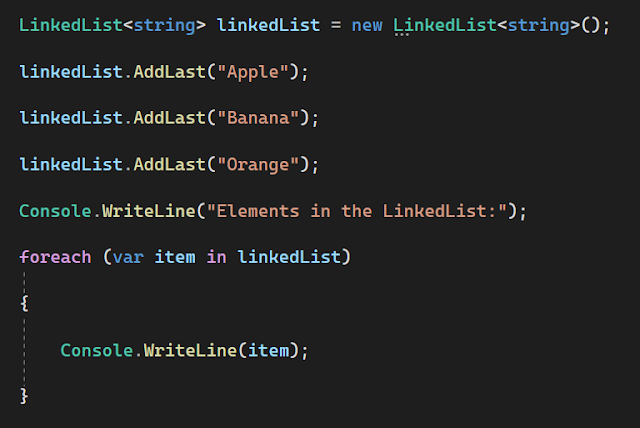What is an ArrayList in C#? Provide a code snippet demonstrating its usage.
An ArrayList is a dynamically resizable array that can store objects of any type. It is part of the `System.Collections` namespace.
Here's a code snippet demonstrating the usage of ArrayList:
What is a BitArray in C#? Provide an example of how it can be used.
A BitArray in C# represents a collection of bits as a compact array of Boolean values. It provides a memory-efficient way to manipulate individual bits.
Here's an example of how BitArray can be used:
What is StringCollection in C#? How is it different from other collection classes?
StringCollection in C# is a collection class specifically designed to store and manipulate a collection of string values. It is part of the `System.Collections.Specialized` namespace.
The difference between StringCollection and other collection classes like ArrayList is that StringCollection is strongly-typed and can only store string values. It provides additional methods and events specific to string manipulation, such as Insert, Remove, IndexOf, and StringCollectionChanged.
What is a Hashtable in C#? How does it differ from other collection classes?
A Hashtable in C# represents a collection of key-value pairs, where each key is unique. It provides fast lookup and retrieval of values based on the associated keys using a hashing algorithm. It is part of the `System.Collections` namespace.
The main difference between Hashtable and other collection classes like ArrayList is that Hashtable requires unique keys and allows for efficient key-based lookup. It does not preserve the order of elements. The keys and values in a Hashtable can be of any type.
What is a SortedList in C#? How is it different from other collection classes?
A SortedList in C# is a collection of key-value pairs that are sorted by the keys. It provides fast lookup by key and maintains the elements in a sorted order based on the keys. It is part of the `System.Collections` namespace.
The key difference between SortedList and other collection classes is that SortedList automatically maintains the elements in a sorted order based on the keys. This allows for efficient searching and retrieval operations. However, SortedList may have slightly slower insertion and removal compared to other non-sorted collections.
What is ListDictionary in C#? How does it differ from other dictionary classes?
ListDictionary in C# is a simple implementation of the IDictionary interface using a singly linked list. It is part of the `System.Collections` namespace.
ListDictionary differs from other dictionary classes like Hashtable and SortedList in terms of its implementation and performance characteristics. ListDictionary is optimized for small collections or scenarios where memory usage and performance are not critical factors. It provides dictionary-like functionality with basic operations such as Add, Remove, Contains, and accessing elements by key. However, ListDictionary does not guarantee any specific order for its elements.
What is a HybridDictionary in C#? How does it differ from other dictionary classes?
A HybridDictionary in C# is a dictionary class that uses a list-based implementation for small collections and a hashtable-based implementation for larger collections. It is part of the `System.Collections.Specialized` namespace.
The main difference between HybridDictionary and other dictionary classes like Hashtable is its hybrid implementation. It dynamically switches between a list-based implementation and a hashtable-based implementation based on the number of elements in the collection. This allows for memory-efficient usage for small collections and optimized performance for larger collections.
What is a Queue in C#? Provide an example demonstrating its usage.:
A Queue in C# represents a first-in, first-out (FIFO) collection of objects. It is part of the `System.Collections` namespace.
Here's an example of how Queue can be used:
What is a Stack in C#? How does it differ from other collection classes?
A Stack in C# represents a last-in, first-out (LIFO) collection of objects. It is part of the `System.Collections` namespace.
The main difference between a Stack and other collection classes is that it follows the LIFO principle. Elements are added to and removed from the top of the stack. It provides operations such as Push (add an element to the top), Pop (remove and return the top element), and Peek (retrieve the top element without removing it).
What is a HashSet in C#? Provide an example demonstrating its usage.
A HashSet in C# is a collection class that stores unique elements in no particular order. It provides fast lookup and insertion operations based on the element's hash code. HashSet is part of the `System.Collections.Generic` namespace.
Here's an example of how HashSet can be used:
What is a LinkedList in C#? Provide an example demonstrating its usage.
A LinkedList in C# is a collection class that represents a doubly-linked list. It allows efficient insertion, deletion, and traversal of elements. LinkedList is part of the `System.Collections.Generic` namespace.
Here's an example of how LinkedList can be used:
What is a Dictionary in C#? How does it differ from other collection classes?
A Dictionary in C# is a collection class that represents a generic key-value pair. It provides fast lookup and retrieval of values based on the associated keys. Dictionary is part of the `System.Collections.Generic` namespace.
The main difference between a Dictionary and other collection classes like Hashtable is that Dictionary is a strongly-typed collection that ensures type safety at compile-time. It provides generic methods and avoids boxing/unboxing of values. Dictionary requires unique keys and offers efficient key-based lookup.
Here's an example of how Dictionary can be used:
ArrayList vs. ListDictionary:
- ArrayList is a dynamically resizable array that stores objects, while ListDictionary is a simple implementation of IDictionary using a singly linked list.
- ArrayList allows storing objects of any type, while ListDictionary is specifically designed for storing key-value pairs.
- ArrayList does not maintain any specific order for its elements, while ListDictionary stores elements in the order of insertion.
BitArray vs. Hashtable:
- BitArray represents a collection of bits, while Hashtable represents a collection of key-value pairs.
- BitArray stores individual bits as Boolean values, while Hashtable stores arbitrary objects associated with unique keys.
- BitArray is suitable for scenarios involving bit manipulation, while Hashtable is commonly used for efficient key-based lookup and retrieval.
StringCollection vs. SortedList:
- StringCollection is a collection specifically designed for storing and manipulating a collection of string values, while SortedList is a collection of key-value pairs sorted by the keys.
- StringCollection is strongly-typed and can only store string values, while SortedList can store any type of object.
- StringCollection provides additional methods and events specific to string manipulation, while SortedList offers fast key-based lookup and maintains the elements in a sorted order based on the keys.
Hashtable vs. SortedList:
- Hashtable represents a collection of key-value pairs, while SortedList is a collection of key-value pairs sorted by the keys.
- Hashtable uses a hashing algorithm for fast lookup and retrieval based on keys, while SortedList maintains the elements in a sorted order based on the keys.
- Hashtable does not preserve the order of elements, while SortedList guarantees that the elements are stored in a sorted order based on the keys.
ListDictionary vs. HybridDictionary:
- ListDictionary is a simple implementation of IDictionary using a singly linked list, while HybridDictionary is a dictionary that uses a list for small collections and a hashtable for larger collections.
- ListDictionary is optimized for small collections or scenarios where memory usage and performance are not critical, while HybridDictionary dynamically switches between list-based and hashtable-based implementations based on the number of elements.
- ListDictionary does not guarantee any specific order for its elements, while HybridDictionary provides efficient memory usage for small collections and optimized performance for larger collections.
Queue vs. Stack:
- Queue represents a first-in, first-out (FIFO) collection, while Stack represents a last-in, first-out (LIFO) collection.
- Queue supports operations like Enqueue (add element to the end) and Dequeue (remove and return element from the front), while Stack supports operations like Push (add element to the top) and Pop (remove and return element from the top).
- Queue is suitable for scenarios where order of insertion is important, while Stack is useful when you need to access the most recently added elements first.
HashSet vs. SortedSet:
- HashSet is an unordered collection that stores unique elements, while SortedSet is an ordered collection that stores unique elements sorted in ascending order.
- HashSet provides fast lookup and insertion operations based on the element's hash code, while SortedSet maintains elements in a sorted order based on their natural ordering or a custom comparer.
- HashSet is suitable when order is not important, and fast lookup and insertion are desired, while SortedSet is useful when maintaining elements in a sorted order is a requirement.
LinkedList vs. ArrayList:
- LinkedList is a collection that represents a doubly-linked list, while ArrayList is a dynamically resizable array.
- LinkedList provides efficient insertion and removal operations, especially in the middle of the collection, while ArrayList offers fast random access to elements based on index.
- LinkedList is suitable when frequent insertion or removal of elements is required, while ArrayList is useful when random access to elements by index is more important.
Dictionary vs. Hashtable:
- Dictionary is a generic collection that represents a key-value pair, while Hashtable is a non-generic collection that also represents a key-value pair.
- Dictionary ensures type safety at compile-time, while Hashtable requires boxing/unboxing of values.
- Dictionary is faster and more efficient due to its generic nature, while Hashtable is slower and less efficient due to boxing/unboxing and lack of type safety.
SortedList vs. SortedDictionary:
- SortedList is a collection of key-value pairs sorted by keys, while SortedDictionary is a generic collection of key-value pairs sorted by keys.
- SortedList uses an internal array to store elements, while SortedDictionary uses a binary search tree.
- SortedList provides efficient key-based lookup and is useful when both key-based lookup and index-based retrieval are required, while SortedDictionary offers faster insertion and removal operations.
.png)








No comments:
Post a Comment